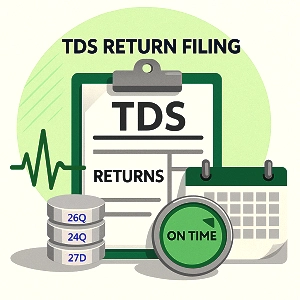TDS Return Filling
Update on: 07-March-2023 09:07:22 AM | Published on: 17-November-2020 11:06:43 AM | 11 Minutes Read
TDS Return Filling in India.
Table of Contents

TDS Return Online Filing Process, Due Dates | e-startup.in
- File your TDS Return before due date.
- Easy Process to File your TDS Return
- Quick TDS Return Filing by Expert
What is TDS?
Tax Deducted at Source (TDS) refers to the amount of tax deducted from the money paid at the time of making specified payments such as rent, commission, professional fees, salary, interest, etc. This tax is deducted by the persons making such payments. With the help of TDS provisions, the Government ensures that the income tax is deducted in advance from the payments being made by a person. The recipient of income receives the net amount (after deducting TDS) which may be in the form of cash or cheque or credit in the payee's account. Person deducting the tax is known as ‘deductor’ and the person whose tax is being deducted is known as ‘deductee’.
Enterslice helps in filing your TDS returns appropriately. While filing the return of income, the recipient adds the gross amount to his income and the amount of TDS is adjusted against his final tax liability. The recipient is allowed to take the credit of TDS already deducted from his income during the financial year.
TDS is deducted at what rates?
On salary income, TDS is deducted depending upon the income tax slab rates applicable to a person. For other types of income such as rent, interest on securities, insurance commission, dividend, etc. the TDS rates are fixed and vary between 10% and 20%.
We help you to compute your annual income by aggregating income from all sources and the actual tax liability is calculated on the total taxable income. From the taxes calculated, one can claim the credit for TDS deducted on their various receipts.
What is TAN?
TAN stands for Tax Deduction Account Number or Tax Collection Account Number and is a ten-digit alphanumerical number issued by the department. It is required to be obtained by all those persons who are responsible for deducting tax at source (TDS) or collecting tax at source (TCS). Section 203A of the Income Tax Act requires that all persons liable to deduct TDS are mandated to quote their TAN number in respect of all communications with the Income Tax department. Failure to this may attract a penalty of Rs. 10,000.
What is a TDS Return Filing?
TDS return filing is a quarterly statement to be submitted to the Income Tax Department and is required to be submitted by the deductor (i.e. all persons responsible for deducting TDS). TDS Return contains the details of TDS deducted and deposited by deductor, PAN of deductor and deductee, TDS challan information, type of payment, amount of TDS deducted, etc. There are different TDS forms that are prescribed for filing TDS Returns depending upon the purpose of deducting TDS. The TDS return filing must be done by every assessee who has deducted TDS at prescribed intervals.
An investment proof may be submitted by an employee to his/her employer for the purpose of claiming deductions and, therefore, his taxable income falls below the maximum amount not chargeable to tax. In such cases, no TDS should be deducted by the employer.
What are the Types of TDS forms?
There are several types of TDS return filing forms that are prescribed dependent upon the purpose of deduction of source (TDS). Following are various types of TDS forms:
- Form 24Q, which represents the statement for tax deduction at source from salary income (TDS on salary).
- Form 26Q, which is for the statement for tax deduction source (TDS) on all payments except for the salary income.
- Form 27Q, which is the statement for the tax deduction of source on all payments made to non-residents other than that of salaries.
- Form 27EQ, which is the statement for the collection of tax at source
The return statement of quarterly TDS needs to be accompanied with a signed in FORM 27A, which is a control chart of all the quarterly TDS or TCS statements. Such form is to be filed by those deducting or collecting tax along with quarterly TDS/TCS statements. It acts as a summary of TDS return filing or TCS returns that are containing the totals of amount that’s paid and the income tax that’s deducted at source.
What are the due dates for filing of TDS Returns?
The persons making specified payments as mentioned under the Act are needed to deduct TDS at the time of making specified payments or credit thereof. However, no TDS will be deducted where the payer is an individual or HUF whose books of accounts are not required to be audited.
| Quarter Period | TDS Return Due Date for Form 24Q, Form 26Q and Form 27Q | TDS Return Due Date for FORM 27EQ |
|---|---|---|
| Q1 – 1st April to 30th June | 31st July | 15th July |
| Q2 – 1st July to 30th Sept | 31st October | 15th October |
| Q3 – 1st October to 31st December | 31st January | 15th January |
| Q4 – 1st Jan to 31st March | 31st May | 15th May |
What is TDS credit certificate?
Form 16, Form 16A, Form 16B and Form 16C are different kinds of TDS certificates which have to be issued by persons deducting TDS on behalf of the Government. Such certificates are issued to the assessee from whose income TDS amount was deducted while making payment. For example, Form 16 is for TDS on salary payment, Form 16A is for TDS on non-salary payments, Form 16B is for TDS on sale of property and Form 16C is for TDS on rent.
TDS deductions are linked to PAN numbers for both the deductor and deductee. The Tax Credit Form 26AS is a consolidated tax statement which is available to all PAN holders. Since all TDS is linked to your PAN, Form 26AS gives the details of all TDS deducted by each deductor for all kinds of payments made to a person – whether those are salaries or interest income.
What is the Process of TDS Return Filing online?
Online filing is more convenient method for TDS Return Filing. For this purpose one has to register to NSDL before. Following are the steps on how to file income tax return online:-
- The format of the file or the data structure in which e-TDS or e-TCS return is to be filed must be prepared.
- Once that is done, the e-filing of TDS return is made according to the formats in a clean text ASCII format with the file extension of “txt”. E-TCS or e-TDS return filing should be or can be prepared with the help of using return preparation utility provided by either the NSDL or by means of any other third party software.
- Once your file is prepared, as per how the file format should be it’s time to verify it by using file validation utility or FVU which is also provided by NSDL.
- Just in case the file has got any errors, the FVU will then give a report of those errors. You can rectify those errors and then verify the file again via FVU.
- The generated “.fvu” file can then be submitted to TIN-FC and then uploaded to the government income tax e-filing website.


